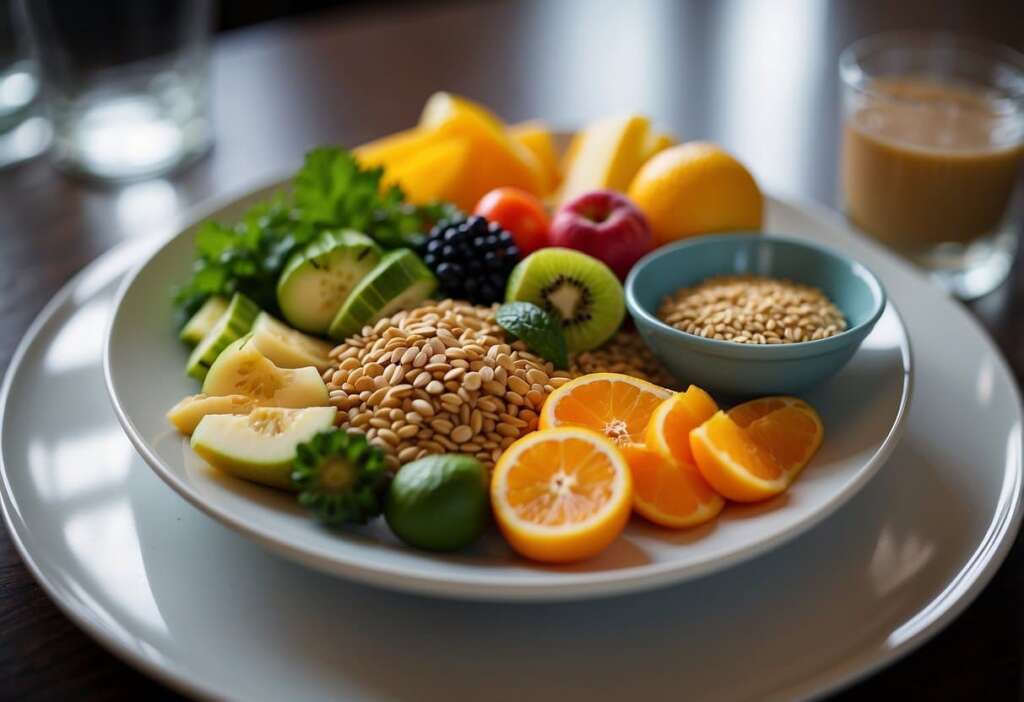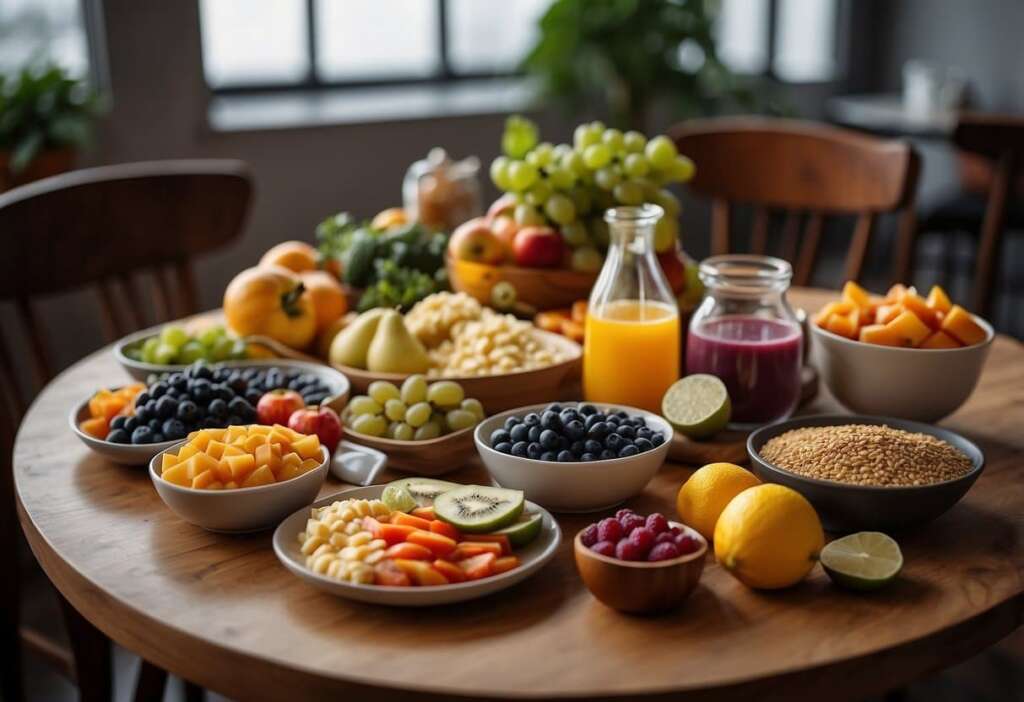Crafting the perfect meal does not have to be a daunting task. A balanced meal template emphasizes the right mix of proteins, carbohydrates, and healthy fats in appropriate proportions. Precision Nutrition provides a comprehensive guide that simplifies this into five steps, ensuring meals are both nutritious and enjoyable.

For those seeking practical examples, Greatist offers a 1-day menu that includes all necessary nutrients. This can be an ideal starting point for individuals with busy schedules who still want to meet their dietary needs and maintain good health.
Additionally, resources like the Healthy Eating Plate from Harvard can guide individuals in structuring their meals effectively. This tool is useful for anyone looking to enhance their nutrition strategy, making balanced and healthy eating more accessible.
Creating Balanced Meals

Building balanced meals requires attention to diverse food groups, appropriate portion sizes, and consideration of various dietary restrictions. This approach ensures nutritional adequacy and helps maintain overall health.
Incorporating Diverse Food Groups
To create balanced meals, it’s essential to include a variety of food groups. Vegetables and fruits should make up about half of the meal, providing vitamins, minerals, and fibre. Whole grains, such as brown rice, quinoa, and whole wheat pasta, are key for energy and additional fibre.
Proteins are crucial for muscle repair and overall health. Options include lean meats like chicken and fish, legumes, nuts, and seeds. Dairy products, such as milk, cheese, and yogurt, offer calcium and vitamin D. By regularly including these food groups, one can achieve a nutritionally balanced diet. For more ideas, check out this balanced meal template.
Healthy Portion Sizes
Healthy portion sizes help manage calories and prevent overeating. Protein should take up about a quarter of the plate, while whole grains should occupy another quarter. The remaining half of the plate is reserved for vegetables and fruits.
Using smaller plates can aid in portion control. Measuring food with tools such as cups and scales ensures accurate portion sizes. Additionally, mindful eating – paying attention to hunger cues and eating slowly – can assist in preventing overconsumption. Recommendations from dietitians can provide personalized guidance tailored to individual needs. More details can be found here.
Considering Dietary Restrictions
When planning meals, it’s vital to consider dietary restrictions. Individuals with allergies or food sensitivities should avoid problematic foods and find suitable alternatives. For example, those with lactose intolerance might choose lactose-free dairy or plant-based milk.
Vegetarians and vegans can focus on plant-based sources of protein like legumes, tofu, and seitan. Gluten-free diets require the exclusion of wheat, barley, and rye, opting instead for grains like quinoa and rice. Consulting a dietitian can help in creating a meal plan that adheres to these dietary needs and ensures nutritional adequacy.
Meal Planning Strategies
Effective meal planning can make a significant difference in maintaining healthy eating habits, saving time and money, and reducing stress throughout the week. Key strategies include planning meals for different times of the day, preparing meals for convenience and savings, and adapting meals to cultural preferences.
Planning for Different Times of the Day
To cater to various nutritional needs and preferences, it’s essential to plan meals for breakfast, lunch, dinner, and snacks.
Breakfast: Consider items rich in nutrients and quick to prepare, such as oatmeal with fresh berries and nuts. Healthy choices like these can boost morning energy levels and keep one full until lunch.
Lunch: For a balanced lunch, include whole grains, lean proteins, and vegetables. For example, a quinoa salad with grilled chicken and mixed greens can be prepared ahead and stored for the week.
Dinner: Dinners can be more substantial. Options like barley, farro, and various types of rice (long grain, short grain, basmati, brown) combined with protein and vegetables create balanced evening meals. Incorporate quick recipes to reduce prep time, such as stir-fries or sheet pan dinners.
Snacks: Keep a well-stocked pantry with healthy options like nuts, fruits, and whole-grain snacks. These quick options can prevent overeating during meals and maintain energy levels throughout the day.
Meal Prep for Convenience and Savings
Meal prep involves organizing and preparing ingredients and dishes in advance to save time and money during the week.
Grocery Shopping: Choose a specific day of the week for planning and shopping. Creating a detailed grocery list helps ensure that all necessary ingredients are available and can prevent impulse buying, which saves money.
Batch Cooking: Preparing large portions of meals like soups, stews, and casseroles helps in having nutritious meals ready to go throughout the week. These can be portioned and stored, making weekday dinners quick and convenient.
Storage: Invest in quality storage containers for organized meal prep. Labelling and dating each container ensures meals are consumed within a safe timeframe, reducing food waste.
Adapting Meals to Cultural Preferences
Incorporating cultural preferences into meal planning can enhance satisfaction and adherence to a meal plan.
Inclusion of Traditional Foods: Respecting cultural traditions by including staple foods like rice, lentils, or tortillas can help in maintaining a connection with one’s heritage while following a healthy meal plan. This also ensures that meals remain enjoyable and familiar.
Variety: Diverse cuisines can be incorporated by experimenting with different spices, herbs, and ingredients. For example, using turmeric and cumin for a curry or soy sauce and ginger for a stir-fry can blend traditional flavours with convenience.
Flexibility: Adapt recipes to accommodate dietary restrictions or preferences. For instance, substituting tofu for meat in traditional dishes can make a meal plan more inclusive for vegetarians or people with specific health needs.
Examples of Nutrient-Rich Foods

A perfect meal incorporates a variety of nutrient-dense foods, each contributing valuable vitamins, minerals, fibre, and healthy fats. This balanced approach ensures your body receives the essential nutrients it needs for optimal health.
Fruits and Vegetables
Fruits and vegetables provide essential vitamins, minerals, and fibre. Some top choices include spinach, kale, and broccoli, which are high in vitamins A, C, and K. Berries, such as blueberries and strawberries, offer antioxidants.
Carrots and sweet potatoes are rich in beta-carotene, promoting good vision. Tomatoes provide lycopene, beneficial for heart health. Peppers, including bell peppers, deliver a significant amount of vitamin C. Avocado is notable for its healthy fats. Including a variety of fresh fruit and steamed broccoli can boost nutrient intake.
Proteins and Legumes
Proteins and legumes are crucial for muscle repair and overall health. Chicken breast and lean cuts of beef offer high-quality protein with minimal fat. Fish like salmon and tuna are excellent sources of omega-3 fatty acids.
Eggs provide a complete protein with the necessary amino acids. Beans and lentils are not only rich in protein but also in fibre and iron, making them ideal for vegetarians. Tofu is another good source of plant-based protein. Nuts like walnuts and peanut butter add healthy fats and protein to meals.
Whole Grains and Healthy Fats
Whole grains and healthy fats are essential for sustained energy. Brown rice and quinoa are rich in fibre and nutrients. Oats provide a high amount of soluble fibre, beneficial for heart health.
Chia seeds and flaxseeds offer omega-3 fatty acids and fibre. Olive oil is an excellent source of healthy fat and can be used in cooking or as a salad dressing. Avocado adds healthy fat and creaminess to dishes. Nuts, such as almonds, provide both healthy fats and protein.
Dairy and Alternatives
Dairy and alternatives offer essential calcium and other nutrients. Greek yogurt is rich in protein and probiotics. Cottage cheese provides a good amount of protein with few calories. Milk supplies calcium, which is crucial for bone health.
For those avoiding dairy, almond milk and soy milk are popular alternatives. Yogurt made from plant-based sources can also be a good option, often fortified with additional nutrients. Including a variety of these options ensures adequate intake of essential nutrients.
Special Considerations in Meal Choices

Selecting the perfect meal involves understanding various special considerations tailored to individual dietary needs, lifestyle, and health objectives. These considerations encompass specific health outcomes, managing food allergies and intolerances, and the impact of lifestyle choices.
Eating for Specific Health Outcomes
When aiming for specific health outcomes, dietary choices can make a significant difference. For instance, heart health can be supported by diets rich in omega-3 fatty acids, whole grains, and leafy greens. Foods that help in controlling blood sugar levels, such as fibre-rich foods, can be crucial for people with diabetes.
Achieving stable energy levels throughout the day is essential. Meals rich in complex carbohydrates, proteins, and healthy fats can sustain energy, preventing dips that lead to fatigue.
In planning meals, it is necessary to consider the age and health status of individuals. For older adults, calcium and vitamin D are vital for bone health, while protein intake helps maintain muscle mass.
Navigating Food Allergies and Intolerances
Managing food allergies and intolerances requires careful menu planning. Those with gluten intolerance or celiac disease need to avoid wheat, barley, and rye, focusing on gluten-free grains like quinoa and rice. Lactose intolerance, on the other hand, necessitates the avoidance of dairy products, substituting with lactose-free or plant-based alternatives.
Nut allergies, which can lead to severe reactions, mean that meals need to be free of all tree nuts and peanuts. Reading labels for hidden allergens and cross-contamination is crucial for safety.
Individual dietary needs often mandate accommodating these restrictions without compromising nutritional balance. Diverse food selections, such as incorporating a variety of fruits, vegetables, and proteins, can help create well-rounded meals.
Impact of Lifestyle Choices
Lifestyle choices heavily influence meal planning. For individuals with high physical activity levels, higher protein and carbohydrate intakes support muscle repair and energy replenishment. Athletes may require more frequent, smaller meals rich in nutrients.
Conversely, for a more sedentary lifestyle, meals lower in calories but high in nutritional value help maintain a healthy weight. Incorporating more vegetables and lean proteins can prevent weight gain and associated health issues.
Dietary habits developed over time also play a role. Establishing a routine that includes balanced meals can lead to healthier eating patterns, supporting long-term health goals.
Incorporating Indulgences and Treats
Balancing healthy eating with occasional indulgences can enhance meal satisfaction and make a diet more sustainable. It’s important to understand how moderation, smart swaps, and mindful eating can help enjoy treats without derailing health goals.
Understanding Moderation
Moderation is key to incorporating treats into a diet. Indulgences like chocolate or desserts can fit into a healthy eating plan when consumed in small amounts. The key is to enjoy these items occasionally and not as a daily habit.
For example, small portions of dark chocolate can be an excellent way to satisfy a sweet craving without excessive sugar intake. By planning these indulgences, individuals can maintain a balanced diet while enjoying their favourite treats.
Smart Swaps for Common Cravings
Common cravings, such as for chips or candy, can often be managed with smart swaps. Opting for dark chocolate instead of milk chocolate reduces both sugar and sodium intake. Similarly, guac can be a healthier alternative to creamy dips, providing good fats without excess sodium.
Another example is replacing high-calorie desserts with a chia pudding or a smoothie made with fresh fruits like strawberries. These swaps can satisfy cravings while offering nutritional benefits and contributing to balanced meals.
Enjoying Meals without Compromising Goals
It’s possible to enjoy indulgent meals without compromising health goals by focusing on balance and portion control. A small treat included in an otherwise healthy meal can improve fulfilment and prevent feelings of deprivation.
For instance, adding a small piece of dark chocolate to a nutritious lunch or incorporating fruits like strawberries into a chia pudding can make meals more enjoyable. This method ensures that treats are part of a balanced diet, promoting both meal satisfaction and long-term adherence to healthy eating habits.
Practical Tips and Simple Recipes
For those aiming to maintain a balanced diet amidst a busy schedule, these practical tips and simple recipes ensure that meals are quick to prepare, healthy, and budget-friendly. Below, find an easy meal and snack ideas, methods for efficient meal preparations, and affordable ingredient suggestions.
Quick and Healthy Snack Ideas
Nuts and seeds provide protein and healthy fats, making them excellent snacks. Almonds, walnuts, and sunflower seeds are easy to carry and do not require refrigeration.
Bananas are another convenient option. They’re rich in potassium, provide natural energy, and can be eaten on the go.
Combine hummus with fresh vegetables like carrots, celery sticks, or green beans for a nutritious and satisfying snack.
For a sweet yet healthy treat, try overnight oats mixed with fruits and chia seeds, which can be prepared the night before.
Simple Meal Preparations
Batch-cooking ingredients in advance can save time. Grilled chicken breasts and steamed vegetables like broccoli and carrots can be stored in the fridge and used throughout the week.
Prepare a large pot of rice or pasta, then mix in different ingredients per meal such as corn, peas, or various sauces to keep meals interesting.
Single-pan recipes are efficient. For instance, a mix of grilled chicken, steamed vegetables, and quinoa can be prepared in a single session and split into multiple meals.
Use quick-cooking ingredients like pre-cooked rice, canned legumes, and frozen vegetables to cut down on cooking time.
Budget-Friendly Ingredients
Incorporate budget-friendly ingredients such as canned beans, which are high in protein and fibre. Black beans, kidney beans, and chickpeas can be used in salads, stews, or wraps.
Peas and corn are affordable and can be easily added to various meals for extra nutrition.
Eggs are versatile and economical. They can be boiled, scrambled, or incorporated into dishes as a protein source.
Utilize whole grains like rice and pasta in bulk purchases, which are often cheaper and provide a solid base for many meals, offering both carbs and dietary fibre.
Frequently Asked Questions

A balanced meal plan encompasses nutritional diversity and incorporates all essential food groups. Recipes that align with ideal dietary guidelines are key to maintaining optimal health.
What does a balanced meal plan encompass for optimal health?
A balanced meal plan for optimal health includes a variety of fruits, vegetables, whole grains, proteins, and healthy fats. It ensures the right intake of vitamins, minerals, and other essential nutrients. Portion control and hydration are also crucial components.
Can you suggest a variety of meal recipes that align with the ideal dietary guidelines?
Recipes such as quinoa salad with chickpeas, grilled chicken with steamed vegetables, and whole-grain pasta with tomato sauce fit well within ideal dietary guidelines. These dishes balance proteins, carbs, and healthy fats.
How can one construct a meal plan that is both satisfying and nutritionally complete?
Constructing a nutritionally complete meal plan involves planning meals, including diverse food groups, and considering individual dietary needs. Tools and guides from Simple’s Experts can be very helpful.
What are the components of a well-rounded meal to eat daily?
A well-rounded daily meal includes lean proteins like chicken or tofu, complex carbohydrates like sweet potatoes or brown rice, healthy fats from avocados or nuts, and a variety of vegetables. Ensuring fibre intake is also important for digestive health.
What constitutes the most nutritious and balanced meal?
The most nutritious and balanced meal combines proteins, carbohydrates, fats, vitamins, and minerals. For example, a meal of grilled salmon, quinoa, and mixed greens with a light vinaigrette covers all these bases.
What are some examples of meals that incorporate all essential food groups?
Meals like a turkey and vegetable stir-fry with brown rice, or a smoothie made with spinach, banana, protein powder, and almond milk, pack all essential food groups. Check out Verywell Fit for more ideas.

